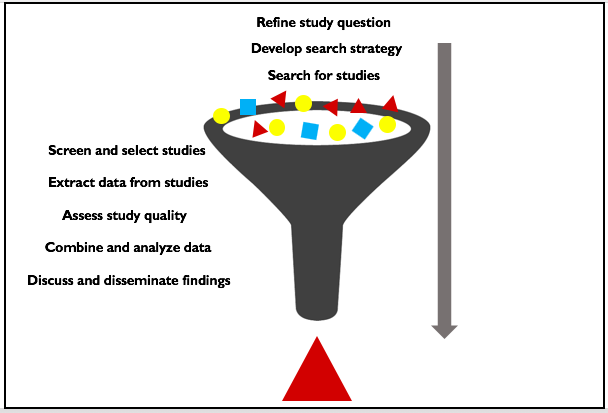An overview of systematic reviews
Overview
Teaching: 15 min
Exercises: 10 minQuestions
What is a systematic review?
What are the steps in a systematic review?
How does an information expert help?
How can a systematic review be automated?
Objectives
Explain the differences between a systematic review and a narrative review
Discuss the roles of an information specialist or librarian in a systematic review
Describe the different steps of the systematic review process
Identify different ways in which automation can facilitate the systematic review process
Systematic reviews defined
Systematic reviews are comprehensive literature reviews conducted using established methods to find, appraise and synthesize existing research to answer a question. Systematic reviews are considered to be a reliable source of evidence to inform decision-making because they gather all of the available research evidence on a topic in an unbiased, transparent and reproducible way.
Systematic reviews differ from traditional, ‘narrative’ literature reviews in the following ways:
| Systematic Reviews | Traditional Literature Reviews |
|---|---|
| The review question is focused, well-defined and specific | The review question is broad or open-ended with vaguely defined concepts |
| Searches for studies are exhaustive, cover many databases and include both peer-reviewed and gray literature sources | Searches in narrative reviews are often non-exhaustive and only include a few sources |
| Searches are reported and well-documented such that they can be reproduced at a later date by other researchers | The method to find studies is often vague if reported at all |
| Studies are selected based on pre-specified, well-defined criteria | Study selection usually involves a ‘cherry-picking’ approach including studies already known to the author |
| Included studies are assessed for study quality and potential biases, and weighted accordingly in the analysis | Included studies are usually not assessed for quality or bias |
| Analysis may include meta-analytical quantitative methods | Analysis tends to be more qualitative in nature |
The steps in a systematic review
A systematic review begins with a well-defined research question. The figure below indicates the step-by-step process used to search for studies, identify studies for inclusion, carry out analyses and report findings.

The role of an information expert
Given the need for comprehensive, reproducible searches and intensive information management, trained librarians and information professionals are a critical component to performing a high quality systematic review.
Information specialists and librarians can assist in the following ways:
- Refining the research topic to an answerable research question appropriate for a systematic review.
- Developing search strategies, including identifying sources to search, harvesting search terms, and designing Boolean search across various databases.
- Gathering and deduplicating bibliographic records resulting from comprehensive database searches.
Automating systematic reviews
Systematic reviews are intensive, time-consuming projects often involving multi-person teams over many months or even 1-2 years or more. Thus, much is underway to identify ways in which parts of the process can be sped up, facilitated or automated.
The R package litsearchr provides a method to facilitate the harvesting of search terms to develop comprehensive search strategies, and to automatically create Boolean searches from lists of keywords, including incorporation of truncation and phrases.
Think-Pair-Share: Reproducibility and search strategies
Think about the process of developing a search strategy for a systematic review. What aspects of this process are reproducible? What aspects are more difficult to reproduce? How do you think a tool like R and litsearchr can help to increase the reproducibility of this process? Share your thoughts with your breakout room group, and then share with the rest of the group by adding a comment to the Etherpad.
Key Points
Systematic reviews differ from traditional literature reviews in a number of significant ways
Systematic review methods strive to reduce bias and increase reproducibility and transparency
Automation and coding software like R can be used to facilitate parts of the systematic review process